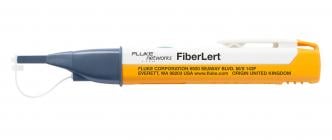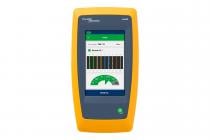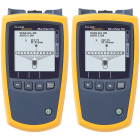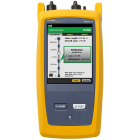What Is Fiber Optics? A Guide
March 20, 2024 / General, 101 learning
Streaming a movie, making a phone call, or getting an endoscopy may seem like disparate experiences, but they share a common thread: They’re connected by an invisible network of optical fibers. In this guide, we’ll take you through the ins and outs of this powerful technology. You’ll learn what fiber optics are used for, how fiber optic cables work, and the benefits they offer.
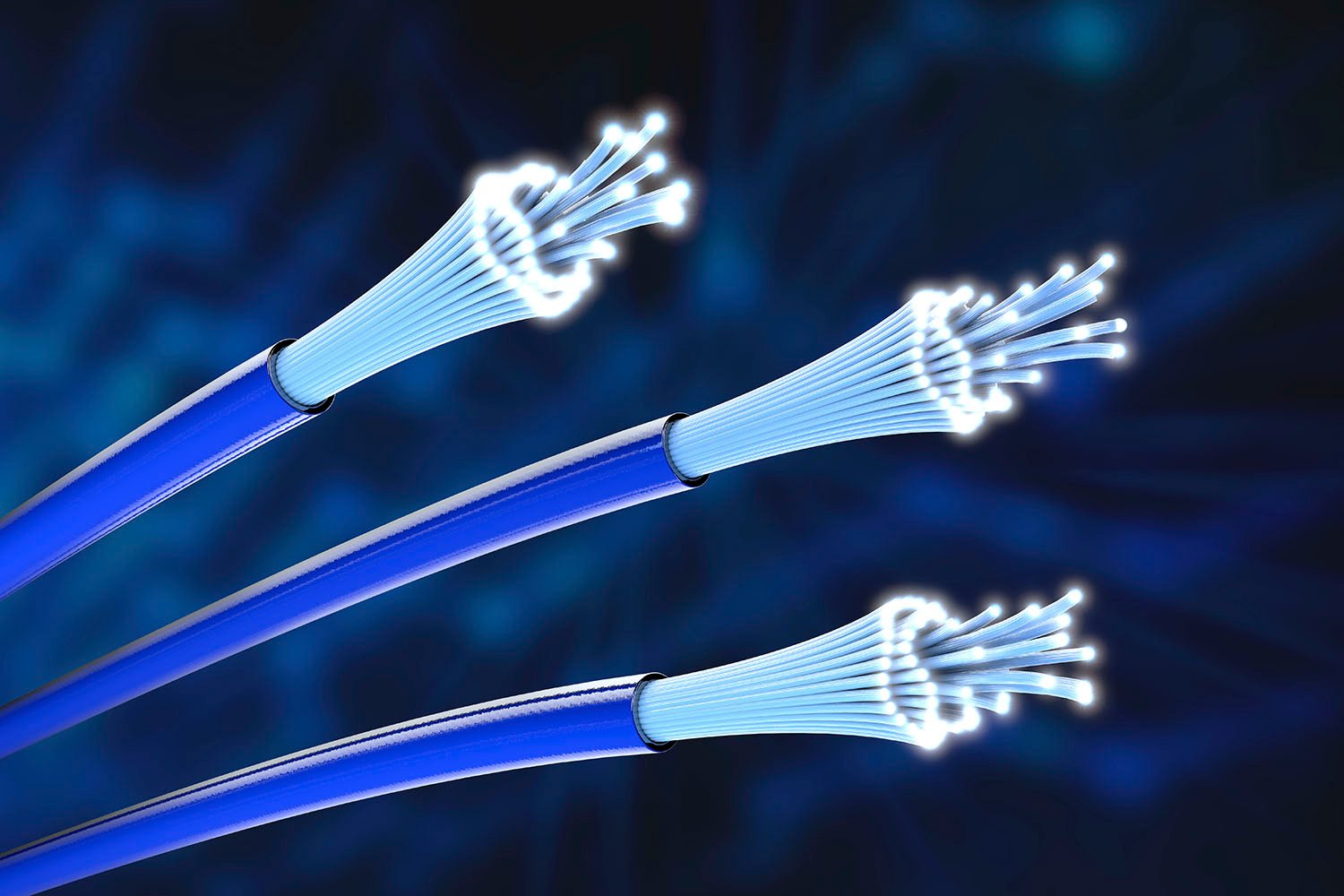
What Is Fiber Optics?
Fiber optics is a technology that utilizes thin threads of glass known as optical fibers. The fibers are commonly bundled by the dozens or even thousands into fiber optic cables. These cables can carry vast amounts of data over long distances with minimal loss.
The use of fiber optics has revolutionized data transmission, resulting in data transfer rates orders of magnitude greater than copper wires are capable of, and over longer distances.
What Is Fiber Optics Used For?
The demand for higher data transmission capacity and speeds continues to grow as network applications expand and organizations collect more data (images, voice, video, etc.) than ever before. This requires cabling that delivers higher bandwidth support. Fiber optic infrastructure is increasingly the go-to medium for datacom networks.
What Are Fiber Optics Made Of?
A fiber optic cable is made of thin strands or threads of glass no thicker than the width of a human hair.
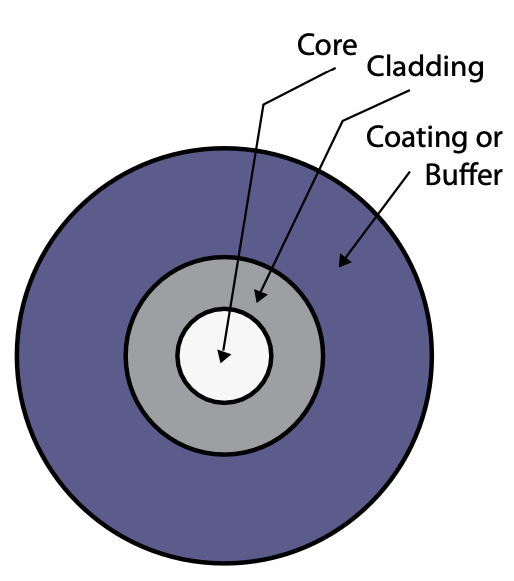
Fiber optic strands consist of a core, a layer of cladding, and an outer coating often called the buffer.
- • The core of a fiber optic cable is made from extremely thin strands of ultra-pure glass. Light signals generated from a source (such as LED or a laser) are launched from a transmitter into the core.
- • A glass layer called the “cladding” surrounds the core of a fiber optic cable and acts as the coating. It reflects light back into the core, helping to maintain signal power.
- • The outer jacket or “buffer” of a fiber optic cable is usually made of a plastic material. It protects the fiber from moisture and damage, preserving the strength of the glass fiber in the core.
Thanks to this combination of specialized layers, light can travel largely unimpeded throughout the cable network. A receiver then receives the signal at the end of a link.
What Is the Purpose of Fiber Optics?
The primary purpose of fiber optic technology is to enable the transmission of large amounts of data at high speeds and with greater reliability. This capability is crucial for supporting the vast, interconnected networks that form the backbone of our digital society, allowing for efficient communication and access anywhere, any time.
Advantages and Disadvantages of Fiber Optic Cables
Fiber optic cables offer numerous advantages over copper cables, including greater bandwidth and higher speed, as well as immunity to electromagnetic interference.
- • Lightning speed: How fast is fast? Fiber optic cables can transmit data at rates up to 800 Gbps (today's data center maximum, but theoretically rates could be even faster). Broadband internet services leverage those cables to deliver some of the fastest internet speeds to millions of customers.
- • Greater bandwidth: Fiber optics can transmit a wide range of light frequencies, transferring more data at higher throughput. For example, a single fiber connection can transfer a movie in HD format in less than a tenth of a second; the typical copper-wire office network would take about a minute to do the same task.
- • Less data loss: Loss or attenuation is a performance measure in cabling and network standards. Optical fiber is less susceptible to data loss from electromagnetic interference from power cabling, radio signals, and even solar flares.
- • No corrosion: Because fiber optic cables are made of non-metallic materials, fiber connections can't corrode. They are, however, vulnerable to contamination by dust and moisture, which is why fiber connections should be inspected regularly and kept clean for best performance.
- • Transmission over longer distances: Copper cable is limited to 100 meters in length without a signal repeater, but fiber optic cables can carry signals for 100 kilometers without losing signal strength.
Fiber optic cabling has some challenges. Although fiber is cost competitive with copper, the electronics needed by a fiber network are more expensive. Fiber optic cable also requires specialized tools, safety rules, and skills in installation, maintenance, and repair; these can be managed with proper equipment, training, and support.
Who Uses Fiber Optics?
From bringing high-speed internet to your fingertips to powering connectivity in smart cities, fiber optics might be one of the most versatile forms of technology currently in existence. Here are a few ways in which it’s used:
-
• Telecommunications and internet
Fiber optics plays a crucial role in broadband internet connections, connecting different networks and data centers, and serving as the backbone of the internet. Cloud computing providers also rely heavily on optical fiber infrastructure. -
• Medical industry
Fiber optics is ideal for use in high-resolution medical imaging. Endoscopy, laser surgery, optical coherence tomography, and photodynamic therapy all make use of fiber optic technology. -
• Transportation
Intelligent transportation systems use fiber optics to power real-time data monitoring, which can be used to help control the flow of traffic, manage toll systems and parking, and monitor the health of railway tracks, among many other applications. And it's not just about the serious stuff — fiber optic cables are used in aircraft entertainment systems because they're lighter (and transmit faster) than copper cabling. -
• Military
Optical fiber provides a secure communication infrastructure that is resistant to electromagnetic interference, eavesdropping, and jamming by adversaries. -
• Industrial automation
Fiber optic cables are often used to transmit data and control signals in environments where high-powered motors, heaters, and similar equipment generate a great deal of interference. Factories and refineries can have very large physical plants, and fiber optics can allow longer network connections for monitoring machinery and controlling processes. Fiber doesn't conduct electricity, which can be a safety issue on long cable runs where the grounding potential can vary from one end of the cable to the other. This property is critical in applications requiring "explosion proofing," such as in grain silos and mines where an electric spark into the environment could be catastrophic. -
• Smart Companies, Campuses, and Cities
Fiber optic technology enables high-speed connectivity, which is crucial for smart city applications and in large offices and campuses as a backbone technology for aggregating large volumes of data over longer distances — from transmitting between floors or buildings to monitoring services, key infrastructure, and safety in high-risk areas.
Types of Fiber Optics
There are two types of fiber: multimode and single-mode. They are distinguishable by their core and cladding diameters.
- • Single-mode fiber: This fiber has a small core that is typically 9 µm wide, and a cladding diameter of 125 µm. Single-mode fiber allows for only one type of light mode to be propagated through the fiber. The transmission is therefore laser-focused and efficient, resulting in minimal signal loss and allowing for high-bandwidth applications over long distances.
- • Multimode fiber: Multimode fiber comes in two core sizes, with diameters of 50 µm and 62.5 µm, and a cladding diameter of 125 µm. With its larger core, multimode fiber can transmit more modes of light simultaneously. Multimode fiber optic cables are ideal for shorter distances in enterprise and data center networks. These cables can be easier to install thanks to their larger cores, which may alignment more straightforward.
|
Single-mode fiber |
Multimode fiber |
|
|
Core diameter |
9 µm |
50 µm (step index) |
|
62.5 µm (graded index) |
||
|
Cladding diameter |
125 µm |
125 µm |
|
Ideal for |
Higher performance, |
Shorter distances, |
Future Trends in Fiber Optics
The future of fiber optics is exciting, with ongoing research and development aimed at further improving the technology.
Data transmission rates have been doubling about every five years, as shown in the graph below from the Ethernet Alliance. The big trend is higher data rates through the same fiber optic cables, which will be instrumental in powering 4K and 8K video, virtual reality applications, and other data-intensive technologies.
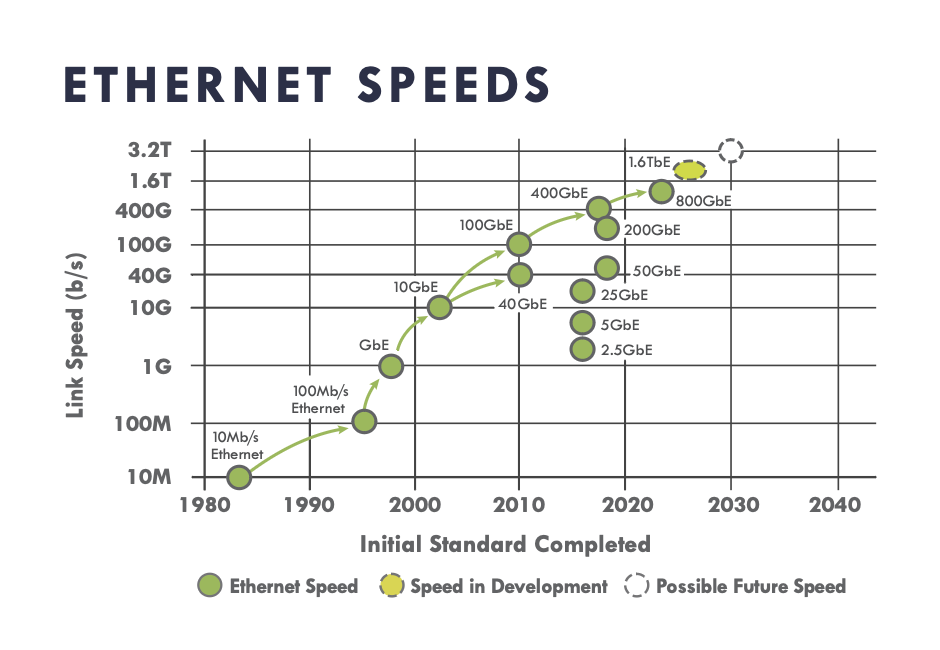
Graph used with permission from the Ethernet Alliance.
Another trend is the use of fiber optics to help meet the demands of 5G networks. This will provide faster and more reliable wireless connectivity, especially in areas with high data demand. Fiber optics will be the backbone for 5G, 5.5G, 6G, and beyond.
Additionally, the miniaturization of fiber optic components and the development of flexible fibers will unlock new applications in Internet of Things (IoT) devices.
The importance of fiber optics for fast data transmission is clear, but there's still so much more this technology can do. Continuing to develop the potential of fiber optics not only promises faster communications but also opens doors to entirely new possibilities — from environmental monitoring to improving safety in our interconnected world.

